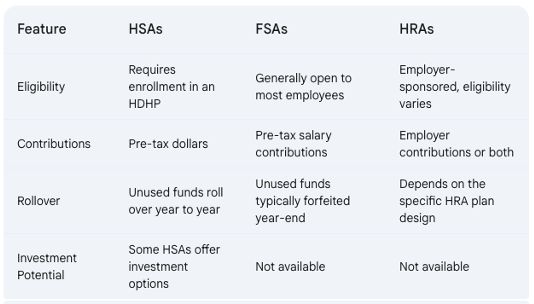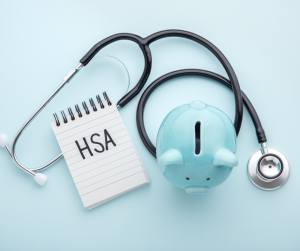
by admin | Aug 2, 2024 | Employee Benefits
 Managing healthcare costs can feel like deciphering a complex code. Three acronyms frequently pop up: HSAs, HRAs, and FSAs. But what exactly do they mean, and which one is right for you? Let’s break down these accounts and explore how they can help you save on qualified medical expenses.
Managing healthcare costs can feel like deciphering a complex code. Three acronyms frequently pop up: HSAs, HRAs, and FSAs. But what exactly do they mean, and which one is right for you? Let’s break down these accounts and explore how they can help you save on qualified medical expenses.
Understanding the Accounts:
-
Health Savings Accounts (HSAs): You contribute pre-tax dollars to your HSA, which acts like a savings account dedicated to qualified medical expenses, including most over-the-counter (OTC) medications. However, to be eligible for an HSA, you must be enrolled in an High Deductible Health Plan (HDHP), which has a higher deductible than traditional health insurance plans. This means you’ll pay more out-of-pocket before your insurance kicks in. HSAs essentially act as a safety net to offset these higher deductible costs.
-
Flexible Spending Accounts (FSAs): These accounts allow you to set aside pre-tax salary contributions to cover qualified medical and dependent care expenses throughout the year. Think of it like a prepaid debit card for approved healthcare costs. Most OTC medications are eligible for reimbursement through an FSA debit card or claim submission process. Unlike HSAs, FSAs are not tied to a specific health insurance plan type, so you might have the option to contribute to an FSA even with a traditional plan (though some employers may have restrictions based on your plan selection). o FSAs have a “use it or lose it” provision: Generally, you must use the money in a FSA within the plan year (but occasionally your employer can offer a grace period of a few months).
-
Health Reimbursement Arrangements (HRAs): These employer-sponsored accounts let companies contribute funds to cover qualified employee medical expenses. The specific eligible expenses, including OTC items, vary depending on the HRA plan design set by your employer. Unlike HSAs and FSAs, you don’t directly contribute to an HRA. Instead, your employer contributes on your behalf, or in some cases, a combination of employer and employee contributions may be allowed.
Who Can Use Them?
-
HSAs: Eligibility hinges on having an HDHP.
-
FSAs: Generally available to most employees, regardless of health plan type (though some employers may restrict enrollment based on plan selection).
-
HRAs: Offered at the discretion of your employer, who determines eligibility and contribution levels.
Tax Benefits:
All three accounts offer tax advantages:
-
Contributions: Reduce your taxable income by contributing pre-tax dollars.
-
Growth: Interest earned on the funds in HSAs and some FSAs (depending on the plan) grows tax-free, allowing your savings to accumulate faster.
-
Withdrawals: When used for qualified medical expenses, withdrawals are tax-free for all three accounts.
Key Differences:

Choosing the Right Account for You:
The best account for you depends on your individual circumstances. Here are some factors to consider:
- Health Status: If you’re generally healthy and have predictable medical expenses, an FSA might be a good choice, allowing you to use the funds throughout the year.
- Financial Risk Tolerance: HSAs offer long-term savings potential with rollovers and investment options (in some plans). However, they require enrollment in an HDHP, which means you’ll shoulder higher upfront costs before insurance kicks in. Consider your comfort level with potentially higher out-of-pocket expenses.
- Employer Benefits: HRAs depend on your employer’s plan design. If your employer offers a generous HRA with significant contributions, it might be a good option for you.
Additional Considerations:
- Use-It-or-Lose-It vs. Rollover: FSAs typically operate on a “use-it-or-lose-it” basis, so plan your contributions carefully to avoid losing funds.
Making an Informed Decision:
By thoroughly understanding HSAs, FSAs, and HRAs, you can choose the account that best aligns with your health needs, financial goals, and employer benefits, ultimately saving you money on healthcare expenses.

by admin | Jul 29, 2024 | Employee Benefits
 Today’s workforce is a mix of generations, and Gen X is a group you can’t afford to overlook. Known for their flexibility and problem-solving skills, Gen X employees bring a powerful combination of experience and value to any company.
Today’s workforce is a mix of generations, and Gen X is a group you can’t afford to overlook. Known for their flexibility and problem-solving skills, Gen X employees bring a powerful combination of experience and value to any company.
Gen X, those born between 1965 and 1980, makes up a significant chunk (27%) of today’s workforce. They’re often in the thick of the “sandwich generation” phase, juggling the needs of aging parents and their own children, all while aiming for career advancement and taking care of themselves. The key to attracting and keeping them? Perks that matter to their lives and priorities.
Healthy Gen X = Happy and Productive Gen X
As we age, health becomes a top priority. That’s why Gen X employees appreciate comprehensive health benefits that go beyond the basics. Offering plans with preventive screenings, broad dental and vision coverage for their families, and well-being programs designed for their age group shows you care – and keeps them healthy, happy, and productive at work.
Work-Life Balance Matters: Offer Flexibility
Life for Gen X can be a juggling act. Flexible work arrangements are more than just a benefit – they’re essential. By offering flexible schedules and remote work options, you acknowledge their responsibilities outside of work and show trust in their dedication. This win-win situation keeps Gen X employees happy and allows them to excel while maintaining a healthy work-life balance.
Gen X and Mental Wellness: Addressing a Unique Need
Having navigated a period of rapid technological and societal change, Gen X may face specific mental health challenges. For this demographic, access to mental health resources carries significant weight. By offering initiatives that promote work-life balance and provide mental health support, employers can demonstrate they care and create a work environment that fosters well-being and maximizes the potential of their Gen X employees.
Gen X and the Retirement Edge: Invest in Their Future
With retirement on the horizon, financial security is a top priority for Gen X. Employers who offer robust retirement savings plans and financial planning resources demonstrate they understand this concern and invest in their employees’ long-term well-being. Further sweeten the deal with student loan repayment programs and life insurance options to ease financial burdens and attract this valuable talent pool. By focusing on Gen X’s financial future, you gain a loyal and engaged workforce ready to contribute their expertise for years to come.
Never Stop Learning: Upskilling Gen X Benefits Everyone
The job market’s always changing so staying ahead of the curve is crucial. Gen Xers, known for their adaptability, value opportunities for continuous learning and professional development. By investing in their growth through training programs and resources, you empower them to excel in their roles, stay relevant in the industry, and feel valued as part of the team. A win-win for both employee satisfaction and company success!

by admin | Jul 23, 2024 | Compliance
 ACA PREVENTIVE CARE MANDATE REMAINS IN PLACE WITH AN EXCEPTION
ACA PREVENTIVE CARE MANDATE REMAINS IN PLACE WITH AN EXCEPTION
In a recent decision, the U.S. 5th Circuit Court of Appeals upheld a key provision of the Affordable Care Act (ACA) that mandates private insurance cover preventive services without cost to patients. However, the court also ruled that the plaintiffs are exempt from complying with this mandate, setting the stage for potential future challenges. The appellate panel emphasized that the task force responsible for determining which preventive services should be covered must receive congressional confirmation, raising questions about the authority of groups making recommendations on contraception and vaccines.
The case stemmed from a lawsuit by Texas-based Christian companies Braidwood Management and Kelley Orthodontics, arguing that the ACA’s requirement to cover preventive care such as contraception, HPV vaccines, and HIV prevention drugs violated their religious beliefs. Initially, a district court sided with the employers, prompting an appeal by the Biden administration.
While the 5th Circuit overturned the lower court’s nationwide nullification of the preventive services mandate, it acknowledged concerns over the constitutional authority of the U.S. Preventive Services Task Force (USPSTF) to issue binding recommendations. The court’s decision requires USPSTF members to undergo presidential nomination and Senate confirmation moving forward.
The ruling’s implications are significant for the approximately 164 million Americans receiving employer-based health insurance, as it preserves access to vital preventive care services. Despite this immediate relief, advocacy groups caution that the decision could pave the way for future legal challenges that may threaten broader access to these essential health benefits.
EMPLOYER CONSIDERATIONS
Employers must ensure that their health plans continue to comply with the ACA’s preventive care mandate, which requires coverage of certain preventive services without cost-sharing for employees. This includes staying updated on the latest guidelines from the U.S. Preventive Services Task Force (USPSTF) and other relevant regulatory bodies to ensure that all mandated services are covered.
HIPAA PRIVACY RULE TO SUPPORT REPRODUCTIVE HEALTH CARE PRIVACY
The Biden administration’s new rule aimed at safeguarding the privacy of protected health information related to lawful reproductive health care went into effect in June. Under the HIPAA Privacy Rule to Support Reproductive Health Care Privacy, healthcare providers are now barred from disclosing sensitive information such as contraception use, pregnancy-related care, and infertility treatments to law enforcement without patient consent.
Effective June 25, with compliance required by December 23, 2024, the rule addresses concerns that arose following the overturning of Roe v. Wade in June 2022. This decision prompted concern that patients seeking lawful reproductive health services across state lines could face unwarranted scrutiny, compromising their privacy and potentially exposing them to legal repercussions.
The rule mandates that HIPAA-covered entities must now obtain a signed attestation that the request is not for prohibited purposes before disclosing protected health information (PHI) for specific purposes like health oversight, judicial proceedings, and law enforcement inquiries.
In the coming months, the Office for Civil Rights plans to release a standardized attestation form to facilitate compliance with the new regulations. This measure aims to ensure that individuals can confidently access reproductive health care without fear of their private medical information being misused or exploited.
EMPLOYER CONSIDERATIONS
Healthcare providers, health plans, and healthcare clearinghouses regulated under the Final Rule must update their Notice of Privacy Practices (NPPs) to align with the requirements for safeguarding reproductive healthcare privacy.
Employers should update HIPAA policies and procedures to ensure they specify when an attestation is required to disclose PHI and train employees on the new rules.
ENFORCEMENT OF PREGNANT WORKERS FAIRNESS ACT BEGINS
Effective June 18, 2024, the Equal Employment Opportunity Commission (EEOC) will enforce the final rule on the Pregnant Workers Fairness Act (PWFA), which mandates that employers provide reasonable accommodations to employees affected by pregnancy, childbirth, or related medical conditions. This applies to all employers with 15 or more employees, encompassing both public and private sectors. Employees are eligible for accommodation regardless of their tenure with the company.
Under the PWFA, employees can request accommodations akin to those permitted under the Americans with Disabilities Act (ADA). These include adjustments such as breaks, modified schedules, remote work, and changes to work environments, among others. Unlike the ADA, the PWFA stipulates four accommodations that employers are generally expected to grant without extensive documentation, such as access to water, restroom breaks, modified seating, and breaks for eating.
Notably, the PWFA requires employers to provide accommodation even if an employee is temporarily unable to perform essential job functions due to pregnancy-related conditions, provided the employee can resume these functions in the near future. Employers cannot mandate specific healthcare providers for medical certification unless certain conditions are met, ensuring flexibility for employees in documenting their accommodation needs.
Regarding undue hardship, employers must assess accommodations based on factors like those used under the ADA, considering the impact on business operations and resources. Accommodations that impose significant costs, disruptions, or alter the fundamental nature of business operations may qualify as undue hardship.
EMPLOYER CONSIDERATIONS
Employers are advised to update their policies and informational materials to reflect PWFA requirements, including handbook updates and the display of updated federal anti-discrimination posters. They should be prepared to accommodate reasonable requests promptly and without unnecessary bureaucratic hurdles, ensuring compliance with both federal and applicable state laws that offer greater protection to pregnant employees.
SUPREME COURT RULES ON MEDICATION ABORTION
The Supreme Court issued a unanimous decision in upholding the FDA’s current protocol for mifepristone, a drug used in medication abortions. The ruling dismissed a challenge based on procedural grounds, asserting that the challengers lacked standing to contest the FDA’s regulations. Despite this decision, the Court left open the possibility of future challenges related to access to the drug.
This ruling holds significant implications, as medication abortion, which includes mifepristone and misoprostol, accounts for a substantial majority of abortions in the United States. The Court’s decision preserves existing access to medication abortion amid rising restrictions on reproductive healthcare.
Currently, coverage for abortion, including medication abortion, varies widely among employers due to state laws and individual plan provisions. While some states mandate coverage, others prohibit it, creating a complex landscape for employers to navigate. Additionally, access to mifepristone can be challenging, as distribution is limited to certified providers, impacting both in-person and mail-order availability.
EMPLOYER CONSIDERATIONS
Employers should review their medical and pharmacy plans to ensure coverage of mifepristone and assess participant access to certified providers.
PREPARATION FOR FILING FORM 5500 FOR CALENDAR YEAR PLANS
ERISA plans with 100 or more plan participants as of the first day of the plan year are required to file IRS Form 5500 by the last day of the seventh month following the end of the plan year. See the IRS Form 5500 Corner for information.
Employers may obtain an automatic extension to file Form 5500, Form 5500-SF, Form 5500-EZ, Form 8955-SSA, or Form 5330 by filing IRS Form 5558. The extension will allow return/reports to be filed up to the 15th day of the third month after the normal due date.
Due to administrative issues within the IRS, electronic filing of Form 5558 through EFAST2 will be postponed until Jan. 1, 2025. Plan sponsors and administrators should continue to use a paper Form 5558 to request a one-time extension of time to file a Form 5500 series or Form 8955-SSA (up to 2½ months after the normal due date for Form 5500s or Form 8955-SSA).
QUESTION OF THE MONTH
Q: For small group clients that do not have to offer medical plans, should we discourage the use of a cafeteria plan for pre-tax premiums if they want to allow employees to drop the medical plan mid-year if they cannot afford it?
A: If you avoid using a cafeteria plan to allow employees to pay for medical premiums, the downside is that the employees must pay for the premiums on an after-tax basis. The upside is you avoid all of the Section 125 rules that generally require elections be irrevocable for the year, unless there is a qualifying life event (and insurance being too expensive is not a qualifying life event). So a good solution for employers that want to offer employees maximum flexibility is to allow them to pay premiums on an after-tax basis.
If giving employees the choice between pre-tax (through a cafeteria plan) or after-tax premiums is too confusing or administratively complex, the employer could choose NOT to offer a cafeteria plan and make all premiums be paid on an after-tax basis. Of course, if the employer does not think the financial hardship issue will occur too frequently, offering a cafeteria plan makes the most financial sense for the employees and the employer.
©2024 United Benefit Advisors

by admin | Jul 15, 2024 | Employee Benefits
 Health savings accounts (HSAs) have become a vital part of many employers’ benefits packages, offering employees a powerful tool to manage healthcare expenses while benefiting from tax advantages. However, managing HSAs goes beyond just facilitating contributions. It also involves understanding and addressing mistakes with distributions that employees might encounter.
Health savings accounts (HSAs) have become a vital part of many employers’ benefits packages, offering employees a powerful tool to manage healthcare expenses while benefiting from tax advantages. However, managing HSAs goes beyond just facilitating contributions. It also involves understanding and addressing mistakes with distributions that employees might encounter.
This article delves into the basics of HSAs, common distribution mistakes, and discusses how employers can assist employees in correcting these errors.
HSA Overview
HSAs are tax-advantaged savings accounts available to individuals enrolled in High Deductible Health Plans (HDHPs). They allow employees to set aside pre-tax dollars to cover qualified medical expenses, providing a triple tax benefit: contributions are tax-deductible, earnings grow tax-free, and withdrawals for qualified medical expenses are tax-free. Contributions to HSAs can come from both employees and employers, with annual contribution limits for individual and family coverage set by the IRS.
Common Mistakes in HSA Distributions
Despite the best intentions, mistakes in HSA distributions can occur. Common errors include:
- Using funds for nonqualified expenses: Employees may inadvertently use HSA funds for expenses that do not qualify as medical expenses under IRS guidelines.
- Overdrawing funds: Employees may withdraw more than necessary from their HSAs, leading to unintended tax consequences.
- Exceeding contribution limits: Employees may contribute more than the IRS annual maximum, resulting in tax consequences.
- Inadequate recordkeeping: Poor recordkeeping can make it difficult for employees to track HSA transactions and verify the eligibility of expenses.
Supporting Employees in Correcting Distributions
As an employer, you can support employees in correcting mistaken HSA distributions in several ways:
- Educate employees: Provide comprehensive education and training on HSA rules and regulations, including eligible expenses, contribution limits, and the consequences of nonqualified distributions. Offer resources such as workshops, webinars, and informational materials to help employees understand how to use their HSAs effectively.
- Encourage recordkeeping: Emphasize the importance of keeping detailed records of HSA transactions and medical expenses. Encourage employees to save receipts and documentation for all qualified medical expenses, as well as records of HSA contributions and distributions.
- Offer guidance and resources: Ensure employees know where to turn for help if they have questions or need assistance with their HSAs. Provide access to knowledgeable benefits administrators, financial advisors, or tax professionals who can offer guidance on correcting mistaken distributions and navigating HSA rules.
- Communicate proactively: Regularly communicate with employees about HSA-related updates, such as contribution limit adjustments, changes to regulations, and reminders about best practices for managing their accounts. Use multiple channels—email, intranet, and employee meetings—to ensure that information reaches all employees.
Conclusion
HSAs provide employees with a valuable opportunity to save for healthcare expenses and offer significant tax benefits. As an employer, it’s essential to support employees in understanding and managing their HSAs effectively. By providing education, resources, and guidance on correcting mistaken distributions, employers can help their workers maximize their HSA benefits while minimizing potential pitfalls. Together, employers and employees can navigate the complexities of HSAs and achieve greater financial wellness.

 Managing healthcare costs can feel like deciphering a complex code. Three acronyms frequently pop up: HSAs, HRAs, and FSAs. But what exactly do they mean, and which one is right for you? Let’s break down these accounts and explore how they can help you save on qualified medical expenses.
Managing healthcare costs can feel like deciphering a complex code. Three acronyms frequently pop up: HSAs, HRAs, and FSAs. But what exactly do they mean, and which one is right for you? Let’s break down these accounts and explore how they can help you save on qualified medical expenses.




